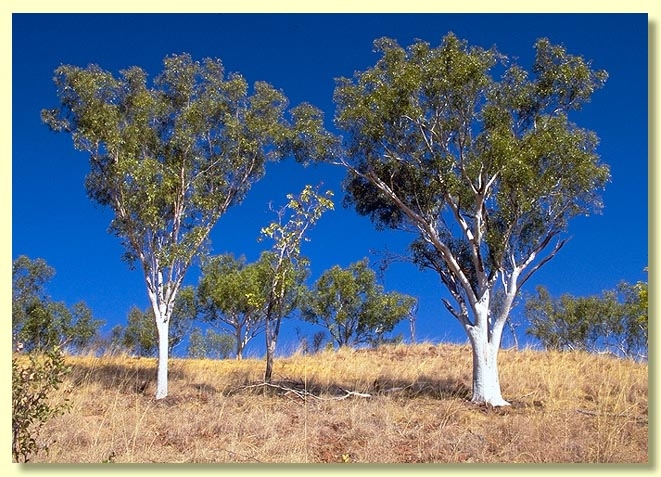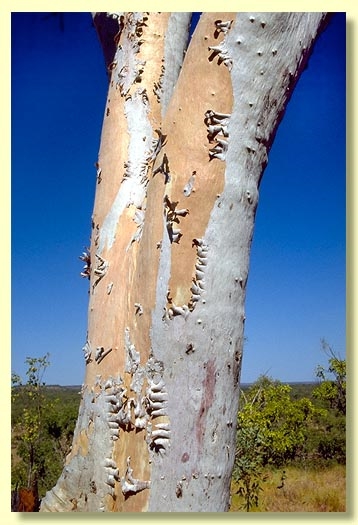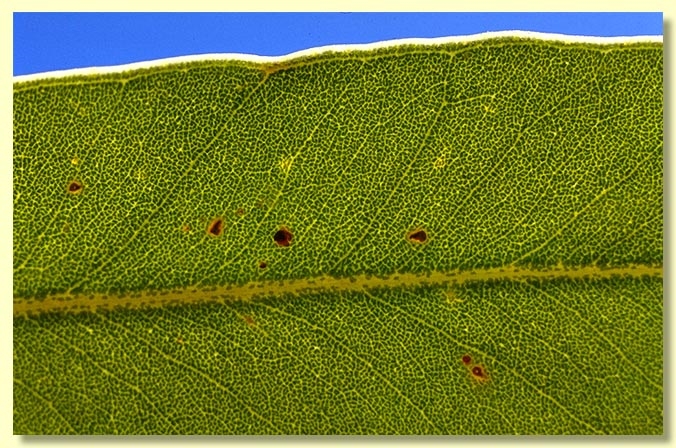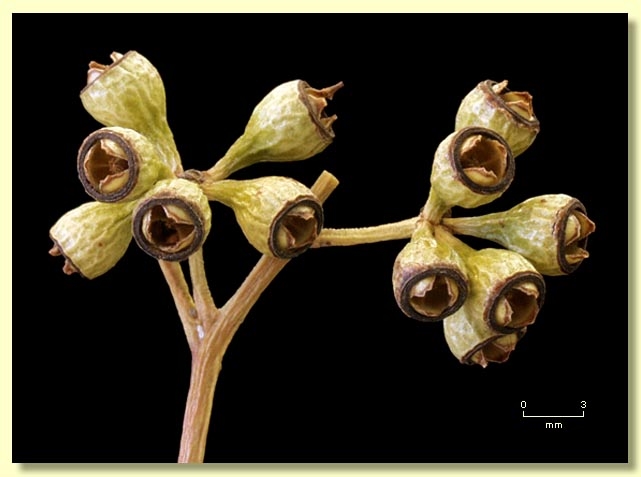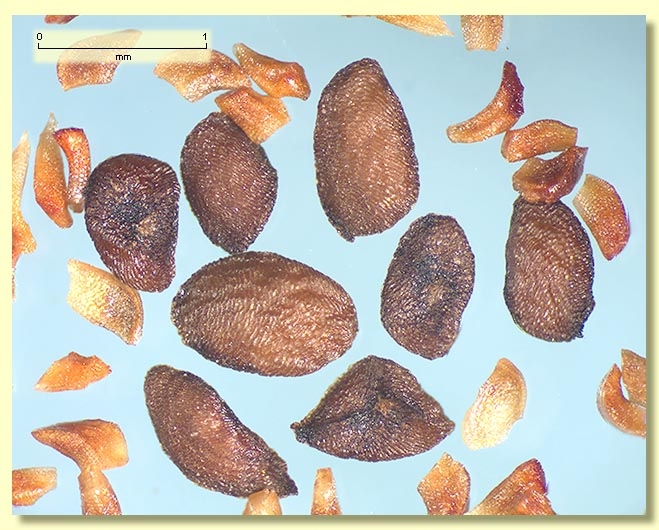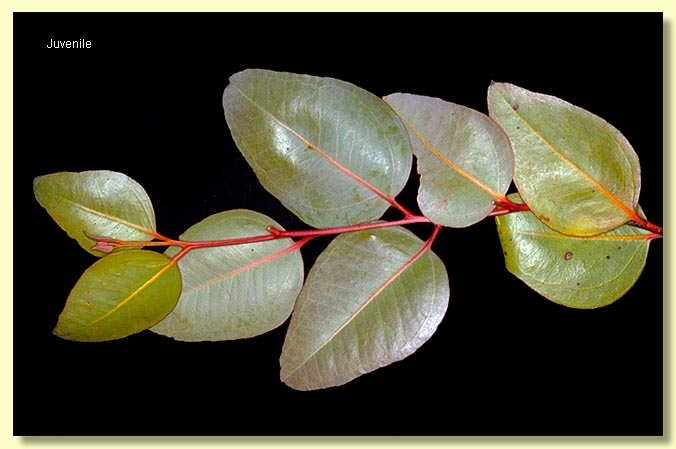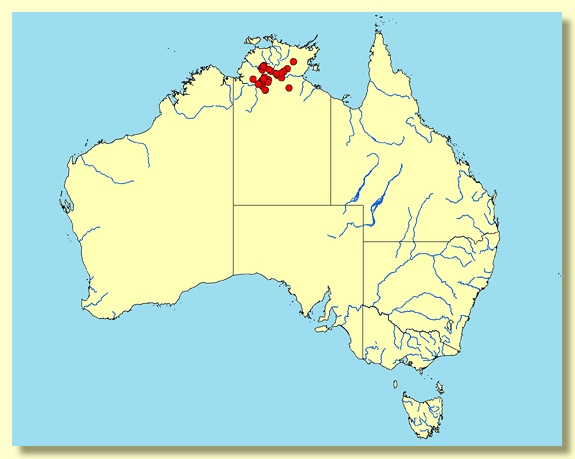Euclid - Online edition
Eucalyptus umbrawarrensis
Eucalyptus | Symphyomyrtus | Platysperma
Eucalyptus umbrawarrensis Maiden, Crit. Revis. Eucalyptus 6: 257 (1922).
T: Northern Territory: Umbrawarra, 5 July 1916, H.I.Jensen 412; holo: NSW; iso: CANB, BRI.
Tree to 18 m tall. Forming a lignotuber.
Bark smooth and powdery throughout, new bark pale yellow to pale pink to pale orange, ageing to white.
Juvenile growth (coppice or field seedlings to 50 cm): stems square to round in cross-section, not glaucous; juvenile leaves always petiolate, alternate, ovate, 4–10 cm long, 3–6.5 cm wide, base rounded, blue-green to green.
Adult leaves alternate, petioles 0.6–1.5 cm long; blade narrowly lanceolate, 6–12 cm long, 0.6–2.2 cm wide, base tapering to petiole, margin entire, apex pointed, concolorous, glossy green, side-veins acute or at a wider angle than 45° to the midrib, reticulation dense to very dense, intramarginal vein close to margin, oil glands apparently absent.
Inflorescence axillary unbranched, peduncles 0.4–0.8 cm long, buds per umbel 7, pedicellate (pedicels 0.2 cm long). Mature buds ovoid to fusiform, 0.5–0.8 cm long, 0.25–0.3 cm wide, scar present, operculum conical to beaked (0.2–0.35 cm long), stamens irregularly inflexed, anthers oblong, versatile, dorsifixed, dehiscing by longitudinal slits, style long and straight, stigma blunt, locules 3(4), the placentae each with 6 or more vertical rows of ovules. Flowers white.
Fruit pedicellate (pedicels 0.1–0.4 cm long), cup-shaped to barrel-shaped, non-glaucous, 0.3–0.5 cm long, 0.3–0.4 cm wide, disc vertically descending, valves 3(4), near the rim or slightly exserted.
Seeds brown to yellowy brown, 1–2 mm long, flattened-ovoid, dorsal surface shallowly reticulate, edge of seed smooth, hilum ventral.
Cultivated seedlings (measured at ca node 10): cotyledons bilobed to kidney-shaped, often only shallowly indented at the apex; stems square in cross-section, slightly glaucous; leaves always petiolate, opposite for c. 3 – 8 nodes then alternate, ovate, 4.5–7 cm long, 2.5–4 cm wide, concolorous, grey-green to slightly glaucous.
Flowering has been recorded in January and October.
A small to medium-sized tree, endemic to the Top End and the Victoria River district of the Northern Territory, on sandstone ridges and escarpments from the Willeroo – Top Springs area, east to the Pine Creek – Mainoru area. Characterised by the smooth white powdery bark, glossy adult leaves and fruit with a narrow descending disc.
Eucalyptus umbrawarrensis belongs in a group of species that are distinguished by having smooth bark, very dense reticulation in the adult leaves and flat, flattened-ovoid, non-toothed, pale yellow-brown to brown seeds with a ventral hilum. The other members of this group are E. kenneallyi, E. rupestris, E. leucophloia, E. confluens, E. brevifolia and E. ordiana.
Within this group, E. umbrawarrensis and E. confluens are the only two species with glossy green adult leaves. These two species can be easily separated by the disc of the fruit. E. umbrawarrensis has a narrow descending disc and E. confluens (like E. brevifolia) has a broad flat to slightly ascending disc. E. brevifolia, E. kenneallyi, E. leucophloia, E. ordiana and E. rupestris all have dull adult leaves.
Within its area of occurrence, E. umbrawarrensis maybe confused with other closely related white gums, i.e. E. apodophylla, E. cupularis, E. glomericassis, E. gregoriensis and E. herbertiana.E. apodophylla is easily distinguished by having relatively large, dull, opposite leaves in the mature crown (usually > 4 cm wide in E. apodophylla but much smaller, usually narrower than 2.5 cm wide, alternate and glossy in E. umbrawarrensis). E. cupularis and E. herbertiana are distinguished by having long lanceolate, dull adult leaves (usually longer than 10 cm in E. cupularis and E. herbertiana but narrowly lanceolate, glossy and less than 12 cm in E. umbrawarrensis). E. herbertiana can be further distinguished by its fruit valves which are prominently exserted and only slightly exserted in E. umbrawarrensis. E. gregoriensis is dull leaved in the mature crown and three-budded in each umbel. (E. umbrawarrensis has glossy leaves and is seven-budded.) Like E. umbrawarrensis, E. glomericassis also has glossy green adult leaves. These two species can be separated on fruit width and disc shape. E. umbrawarrensis has smaller fruit 0.4 cm or slightly less and a narrow descending disc, while E. glomericassis has broader fruit, 0.6 cm or slightly larger and a flat to ascending disc.
Eucalyptus umbrawarrensis: referring to the locality of Umbrawarra, Northern Territory.

